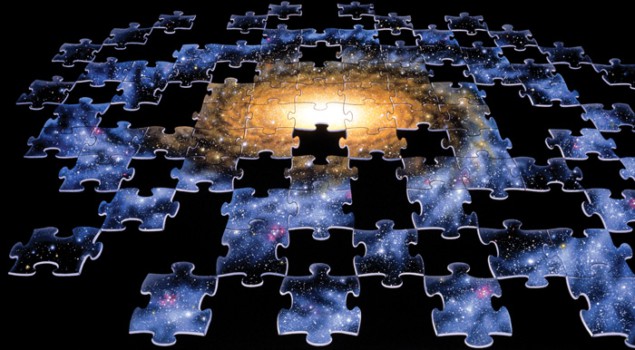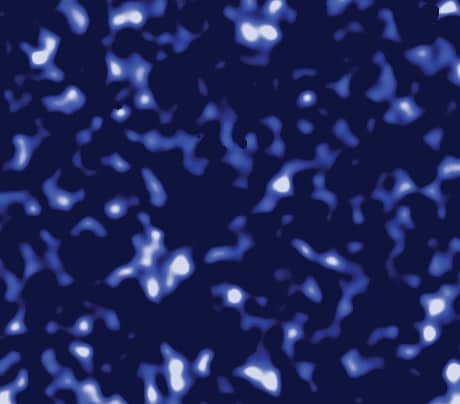Taken from the 25th anniversary issue of Physics World, this article examines one of the five biggest unanswered questions in physics as selected by the magazine’s editors
Just over 95% of our universe comes in the shrouded form of dark energy and matter that we can neither explain nor directly detect. Catherine Heymans explores this enigma and describes where we will look next in our search for darkness

This year the Planck space mission released exquisite observations of the early universe, providing the strongest evidence yet that the universe we live in is very dark indeed. Its precise results show that our universe is composed of 26.8% dark matter and 68.3% dark energy, while less than 5% is made up of the stuff we are familiar with on Earth. With their long-standing quest to make these precision measurements essentially now concluded, cosmologists are rapidly turning their attention to a much bigger and further-reaching question: what is the exact nature of this dark universe?
Dark matter is exactly what it says on the tin: it is dark and comprised of a mysterious substance that does not emit or absorb light. We only know it exists because of its gravitational effects on the normal matter that we can see. Dark energy is less well described by its label, being an invisible source of energy that drives the post-Big-Bang expansion of the universe to mysteriously accelerate. Together, these two dark entities play out a cosmic battle of epic proportions. While the gravity of dark matter slowly pulls structures in the universe together, dark energy fuels the universe’s accelerating expansion, making it ever harder for those dark-matter structures to grow.
It is widely believed that to truly understand the dark universe, we will need to invoke some new physics that will forever change our cosmic view. As the conclusion of this dark quest could be so far reaching, astronomers are approaching the task with care, using a series of independent and meticulous observations. Efforts include the Canada–France–Hawaii Telescope Lensing Survey, which has directly mapped out the invisible cosmic web of dark matter by observing how its mass bends space and time, lensing the light of very distant galaxies. Projects such as the Sloan Digital Sky Survey are accurately charting the locations of billions of galaxies, which closely trace the distribution of dark matter because this gravitationally attractive substance dictates where and when galaxies form. Galaxies also carry with them a signal imprinted in the distribution of normal matter just after the Big Bang that can be seen in how galaxies cluster in the cosmos today.
Capturing dark matter
Astronomers have put their theories of dark matter to the test, finding that a very wide variety of observations all agree with a single theory, termed the “concordant cosmology”. This overwhelming body of evidence supports the theory that dark matter is made up of weakly interacting matter particles (WIMPs), and the challenge is now on for particle physicists to go out and catch or create one.
Several attempts have already been made to trap a dark-matter particle, but any hints of success have so far been controversial and open to interpretation. The next major leap in the search for a fleeting glimpse of a dark-matter particle in flight is taking shape not in space but nearly 1.5 km under the Black Hills of South Dakota. The LUX-ZEPLIN experiment will use nine tonnes of liquid xenon as its dark butterfly net. The hope is that a few of the trillions of WIMPs that pass through the Earth every second will be caught crashing into some of the xenon particles. How successful this new experiment will be in its quest to uncover the nature of dark matter will depend on just how much of a wimp the dark-matter particle turns out to be. An unquestionable direct detection of a dark-matter particle would be one of the most significant discoveries of this century, finally confirming Fritz Zwicky’s theory, which was ridiculed when he proposed it in 1933.
Exposing dark energy
While the astronomical community is now fairly united in postulating the existence of an invisible dark-matter particle, the same cannot be said about its support for the simplest explanation for dark energy. Observations that the expansion of our universe is accelerating are most easily explained by considering the extra energy associated with the vacuum that permeates the universe. According to quantum theory, empty space is filled with a swarm of virtual particles with a wide range of masses that can briefly pop in and out of existence. As mass and energy are equivalent, the growing vacuum within an expanding universe acts like a bank of unlimited energy, inflating the whole universe at an accelerated speed.

Unfortunately, there is a problem with this simple and elegant vacuum solution to the nature of dark energy. Particle physicists can make a theoretical estimate for the energy of a vacuum and they find that it is 120 orders of magnitude larger than the dark energy that the Planck results show. This wild discrepancy has opened up a wide range of exciting new dark-energy theories including exotic models such as a multiverse that resembles the middle of an Aero chocolate bar. Perhaps our universe is one Aero bubble being pulled by our neighbouring Aero-bubble universe?
Many cosmologists believe that the dark-energy phenomenon indicates that we need to look beyond Einstein’s theory of general relativity. By observing how dark-matter structures change over cosmic time, we can investigate how dark energy evolves and test gravity for the first time on cosmological scales. Just as Einstein revolutionized our understanding of Newtonian gravity, confirmed through observations of the solar system, so new observations of gravity on cosmological scales may bring about another revolution in our understanding of gravity.
Two major new international projects will lead our quest to discover what the dark-matter particle is and why the expansion of our universe is apparently accelerating. The Euclid satellite, due to launch in 2020, will image the full dark sky from above the Earth, while the Large Synoptic Survey Telescope, due to see first light in 2019, will image the full Southern sky from a mountain top in Chile. Both of these projects will chart the distant universe with exquisite precision, utilizing a diverse range of cosmological tools to map out the evolution of dark-matter structures and document the expansion and curvature of space and time from 10 billion years ago to the present day. Exciting times are ahead for our understanding of the fundamental physics that govern the dark side of the universe.



